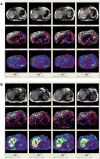Test-retest repeatability of MR elastography for noninvasive liver fibrosis assessment in hepatitis C
- PMID: 21751289
- PMCID: PMC3176946
- DOI: 10.1002/jmri.22716
Test-retest repeatability of MR elastography for noninvasive liver fibrosis assessment in hepatitis C
Abstract
Purpose: To conduct a rigorous evaluation of the repeatability of liver stiffness assessed by MR elastography (MRE) in healthy and hepatitis-C-infected subjects.
Materials and methods: A biopsy-correlated repeatability study using four-slice MRE was conducted in five healthy and four HCV-infected subjects. Subjects were scanned twice on day 1 and after 7-14 days. Each slice was acquired during a 14-s breath-hold with a commercially available acquisition technique (MR-Touch, GE Healthcare). Results were analyzed by two independent analysts.
Results: The intraclass correlation coefficient (ICC) was 0.85 (90% confidence interval [CI]: 0.71 to 0.98) for the between-scan average of maximum stiffness within each slice and 0.88 (90% CI: 0.78 to 0.99) for the average of mean stiffness within each slice for the primary analyst. For both analysts, the average of the mean liver stiffness within each slice was highly reproducible with ICC of 0.93 and 0.94. Within-subject coefficients of variation ranged from 6.07% to 10.78% for HCV+ and healthy subjects.
Conclusion: MRE is a highly reproducible modality for assessing liver stiffness in HCV patients and healthy subjects and can discriminate between moderate fibrosis and healthy liver. MRE is a promising modality for noninvasive assessment of liver fibrosis (CLINICALTRIALS.GOV IDENTIFIER: NCT00896233).
Copyright © 2011 Wiley-Liss, Inc.
Conflict of interest statement
Conflict of interest: Norah J. Shire, Radha A. Railkar, Sabrina Fox-Bosetti, Chan R. Beals, and Bernard J. Dardzinski are Merck employees and may own stock/stock options in Merck.
Figures




Similar articles
-
Rapid acquisition technique for MR elastography of the liver.Magn Reson Imaging. 2014 Jul;32(6):679-83. doi: 10.1016/j.mri.2014.02.013. Epub 2014 Feb 13. Magn Reson Imaging. 2014. PMID: 24637083 Free PMC article.
-
MR elastography for noninvasive assessment of hepatic fibrosis: reproducibility of the examination and reproducibility and repeatability of the liver stiffness value measurement.J Magn Reson Imaging. 2014 Feb;39(2):326-31. doi: 10.1002/jmri.24147. Epub 2013 Apr 15. J Magn Reson Imaging. 2014. PMID: 23589232
-
Correlation of MR elastography with morphometric quantification of liver fibrosis (Fibro-C-Index) in chronic hepatitis B.Magn Reson Med. 2014 Oct;72(4):1123-9. doi: 10.1002/mrm.25002. Epub 2013 Oct 28. Magn Reson Med. 2014. PMID: 24166665
-
Clinical application of transient elastography in patients with chronic viral hepatitis receiving antiviral treatment.Liver Int. 2015 Apr;35(4):1103-15. doi: 10.1111/liv.12628. Epub 2014 Jul 19. Liver Int. 2015. PMID: 24976523 Review.
-
American Gastroenterological Association Institute Technical Review on the Role of Elastography in Chronic Liver Diseases.Gastroenterology. 2017 May;152(6):1544-1577. doi: 10.1053/j.gastro.2017.03.016. Gastroenterology. 2017. PMID: 28442120 Review.
Cited by
-
MR elastography of liver: current status and future perspectives.Abdom Radiol (NY). 2020 Nov;45(11):3444-3462. doi: 10.1007/s00261-020-02656-7. Epub 2020 Jul 23. Abdom Radiol (NY). 2020. PMID: 32705312 Free PMC article. Review.
-
MR elastography of the liver at 3.0 T in diagnosing liver fibrosis grades; preliminary clinical experience.Eur Radiol. 2016 Mar;26(3):656-63. doi: 10.1007/s00330-015-3863-4. Epub 2015 Jun 10. Eur Radiol. 2016. PMID: 26060066
-
Evolving role of magnetic resonance techniques in primary sclerosing cholangitis.World J Gastroenterol. 2019 Feb 14;25(6):644-658. doi: 10.3748/wjg.v25.i6.644. World J Gastroenterol. 2019. PMID: 30783369 Free PMC article. Review.
-
Prediction of nonalcoholic fatty liver disease (NAFLD) activity score (NAS) with multiparametric hepatic magnetic resonance imaging and elastography.Eur Radiol. 2019 Nov;29(11):5823-5831. doi: 10.1007/s00330-019-06076-0. Epub 2019 Mar 18. Eur Radiol. 2019. PMID: 30887196 Free PMC article.
-
Optimization of scanning parameters for MR elastography at 3.0 T clinical unit: volunteer study.Jpn J Radiol. 2014 Jul;32(7):441-6. doi: 10.1007/s11604-014-0320-2. Epub 2014 Apr 28. Jpn J Radiol. 2014. PMID: 24771357
References
-
- Hepatitis C--global prevalence (update) Wkly Epidemiol Rec. 1999;74:425–427. - PubMed
-
- Di Bisceglie AM. Natural history of hepatitis C: its impact on clinical management. Hepatology. 2000;31:1014–1018. - PubMed
-
- Ghany MG, Kleiner DE, Alter H, et al. Progression of fibrosis in chronic hepatitis C. Gastroenterology. 2003;124:97–104. - PubMed
-
- Sebagh M, Rifai K, Feray C, et al. All liver recipients benefit from the protocol 10-year liver biopsies. Hepatology. 2003;37:1293–1301. - PubMed
-
- Strader DB, Wright T, Thomas DL, Seeff LB. Diagnosis, management, and treatment of hepatitis C. Hepatology. 2004;39:1147–1171. - PubMed
Publication types
MeSH terms
Associated data
Grants and funding
LinkOut - more resources
Full Text Sources
Medical

